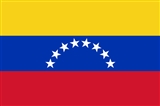
: República Bolivariana de Venezuela), is a tropical country on the northern coast of South America
. It borders Colombia
to the west, Guyana
to the east, and Brazil
to the south. Its northern coastline of roughly 2800 kilometres (1,739.8 mi) includes numerous islands in the Caribbean Sea
, and in the north east borders the northern Atlantic Ocean
. Caribbean islands such as Trinidad and Tobago
, Grenada
, Curaçao
, Bonaire, Aruba
and the Leeward Antilles
lie near the Venezuelan coast.
1498 Christopher Columbus becomes the first European to visit what is now Venezuela.
1558 Mérida is founded in Venezuela.
1567 Don Diego de Losada founds the city of Santiago de Leon de Caracas, modern-day Caracas, the capital city of Venezuela.
1810 Venezuela achieves home rule: Vicente Emparan, Governor of the Captaincy General is removed by the people of Caracas and a Junta is installed.
1811 Venezuela declares independence from Spain.
1812 An earthquake destroys Caracas, Venezuela.
1813 South American independence leader Simón Bolívar enters Mérida, leading the invasion of Venezuela, and is proclaimed ''El Libertador'' ("The Liberator").
1819 Simón Bolívar declares the independence of the Republic of Gran Colombia in Angostura (now Ciudad Bolívar in Venezuela).
1821 The Battle of Carabobo takes place. It is the decisive battle in the war of independence of Venezuela from Spain.
1821 The Republic of Gran Colombia (a federation covering much of present day Venezuela, Colombia, Panama, and Ecuador) is established, with Simón Bolívar as the founding President and Francisco de Paula Santander as vice president. thumb|right|220px|[[Brazil]] declares independence.

